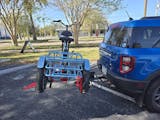
How to Lock Your Bike: A Guide to Avoid your Bike Being Stolen
Share
The heart-wrenching scenario that every cyclist dreads is coming back to their bike and discovering that their lock has been broken and their beloved two-wheeler is nowhere in sight. Bikes are appealing targets for theft as they tend to hold significant value, are frequently left unattended in vulnerable locations, and can be easily transported, disassembled, and disposed of.
The sad truth is that bike theft is an extremely common crime, and because of this, adequate measures to secure one's bicycle are essential. To avoid your bike from being stolen, it is necessary to properly lock it, and understanding how to securely lock your bike will put you one step ahead.
In this article, we will discuss the best ways to lock your bike and keep it safe.

I. Choosing the right location to lock the bike
When it comes to choosing the right location where you should lock the bike, there are certain things that you must remember.
Here are the key tips for picking the right spot for your bike:
- Be mindful of the location; eliminate clues. Urban centers, areas with high concentrations of students, and neighborhoods with high levels of crime are not ideal places to leave your bike unattended for an extended period. It's always preferable if the thief has no idea of when you will be returning your bike.
- Park in busy, well-lit areas. Crowds and lighting deter theft, so park in front of busy stations rather than in dark, unsecured parking. Avoid dark, unused alleys without lights as they're the least safe place to park
- Look for a secure object to attach your bike to, such as a large bike rack or even a lamp post. Make sure to also position your bike in the center of the rack, making it more difficult for thieves to access your lock and use their tools.
Important to note:
Just because your bike is in plain sight or hidden from sight doesn't mean it's secure. Always lock it up, and don't leave it there too long.
II. Choosing your locks
Unfortunately, professional bike thieves are capable of breaking almost any lock, and in the process, they may even leave your bike unusable.
Choosing the right lock and operating it correctly, on the other hand, can significantly reduce the risk of your bike being a target.
Here are the bike locks that you can choose from:
- Lightweight cafe locks
The benefit of a lightweight cafe lock lies in its lightweight design, making it convenient to carry while riding, either in a bag or, more often, in your pocket. The downside is that the protection offered by such locks is minimal. Lightweight locks are often easy to break and can even be cut with just a simple set of wire cutters, or sometimes no tools at all.
It's important to note that a lock of this type should only be utilized for minimal bike security. If you intend to leave your bicycle unattended for an extended period of time or in an area with a potential for theft, it's advisable to use a more robust lock for added protection.
- U-locks
U-locks are popular with cyclists because they strike a balance between portability and weight. A U-lock can be mounted to your bike when not in use and provides a good level of protection without weighing you down too much.
There’s plenty of choice when it comes to U-locks. Most will deter an opportunist thief, but look for a “Sold Secure-rated” lock for improved protection. Brands like Kryptonite, ABUS and Via Velo Bike Lock are one of the highly recommended U-locks.
Via Velo Bike Lock is a heavy duty bicycle U-Lock, has a 14mm shackle and 10mm x1.8m cable with mounting bracket for road bike, mountain bike, electric bike and folding bike.
Another U-lock that you can use is the TiGr mini+ Ulock with reinforced mounting clip by TiGr Lock. The original titanium u-lock is a strong, light, easy to use, and easy to carry ultimate lightweight bike lock for commuting, touring, and riding.
- Chains
Chains are another popular option. The most secure tend to be heavy chain locks with hardened links. A chain lock will often have a cloth sleeve around it to protect your frame (most D-locks are coated in plastic for the same reason).
A chain lock offers the advantage of flexibility, but it is heavy and quite challenging to transport. You can also buy folding locks with joints in them. They are easier to carry, although the joints are vulnerable and need to be strengthened.
- Cable locks
Another option is a standard cable lock. A cable lock can complement a heavier lock for added security. Some cables come with their own lock, while others are designed to be used with a D-lock or padlock. A cable and D-lock combination secures both the frame and wheels without the weight of two heavy locks.
III. How to securely lock up your bike
- Lock to a solid object: Always lock your bike to a solid, immovable object like a bike rack or a street sign. Avoid locking your bike to objects that can be easily cut, like trees or parking meters.
- Use a quality lock: Make sure to secure your rear wheel and the rear triangle of the frame to your chosen anchor point.
If you lock your bike for an extended period of time on the street or in a public garage, or if your bike has quick release wheels, have a second lock because using two locks makes it more difficult for a thief to break through both locks. For example, you can use a U-lock to secure the frame to a bike rack, and a cable lock to secure the wheels to the frame.
- Make it difficult for thieves to break your locks Keep the locks off the ground so potential thieves can’t use it to gain extra leverage when using bolt cutters or as a solid surface for sledgehammers. Fit the locks as tightly around the frame and supports as possible. Leaving too much room inside the lock will also make it easier for a thief to get the leverage required to break it.
Here are a few more tips from New York City Bicycle Habitat's most famous mechanic, Hal Ruzal.
Additional Important Considerations:
- Remove detachable parts: If your bike has any detachable parts, such as a quick-release front wheel, remove these and take them with you.
- Remove accessories: If you can, take all accessories with you. A bicycle is far less appealing without lights and wheels attached to it. A lot of thieves steal bikes and literally ride off on them. Remove the seat post too, and it makes it incredibly hard for a thief to take off.
- Protect Your Bike: Registering your bike with the local police enhances the chances of recovery if it gets stolen. Keep a record of the bike's serial number and take pictures for easier identification in case of theft.
In conclusion, no bike is ever 100% safe. If someone has enough time and determination, they can cut through everything, even if your bikes are already securely locked.
But by incorporating these tips, you can ensure the security of your bike and have peace of mind while on the go. Choosing the right place to lock, utilizing proper locks, locking securely, and registering your bike with the police all increase the likelihood of protecting it from theft.
All Around E-Bikes carefully selects the brands of the most reliable e-bikes on the market. As an authorized dealer of the brands we carry, your purchase is backed by the manufacturer's warranty.
We inspire our readers to ride e-bikes in the park, climb hills, and cycle for alternative transportation. We believe in the amazing transformation that e-bikes provide and are dedicated to spreading the joyful and sustainable experience they provide.
For more information about the e-bikes covered and their features or warranties, you may contact us at 1-888-725-4887.


